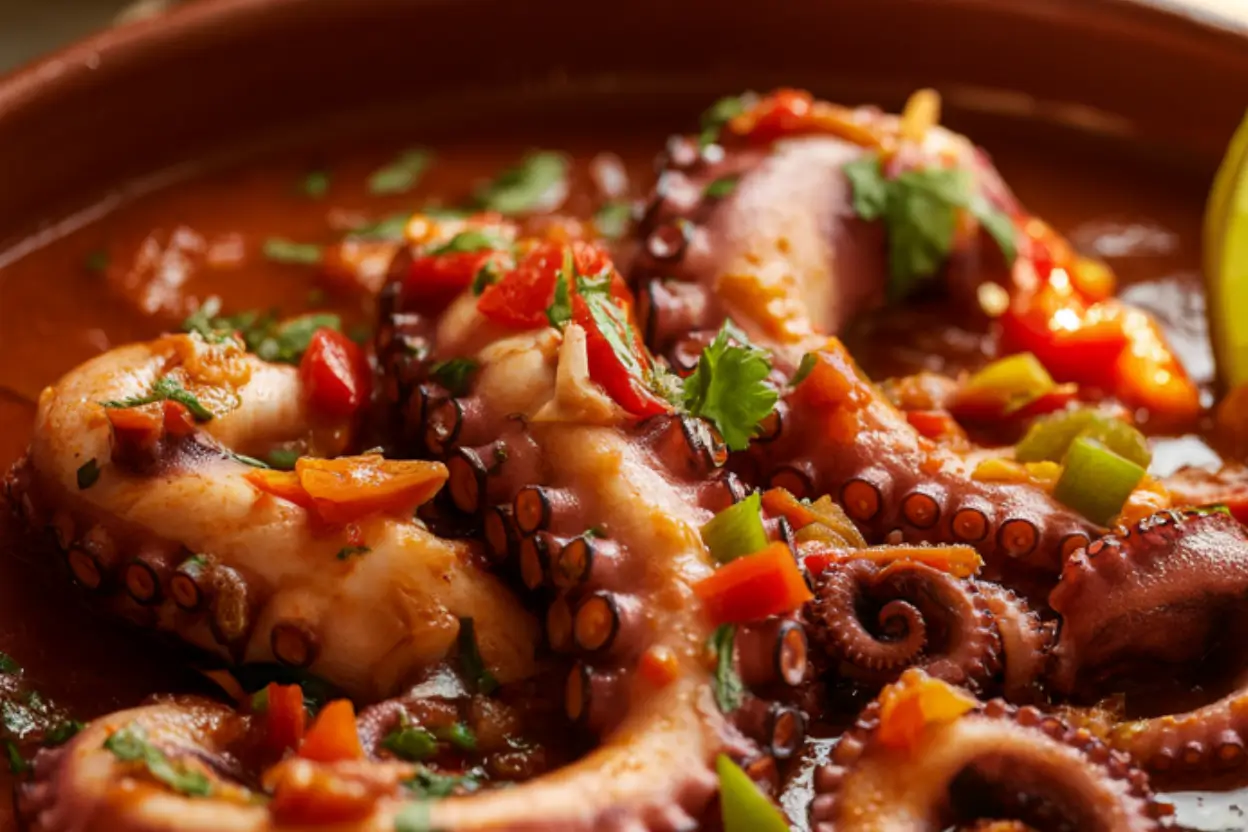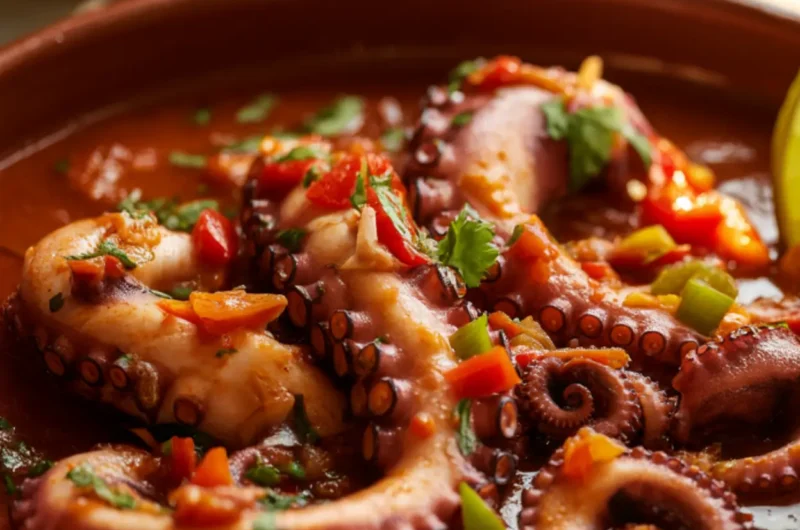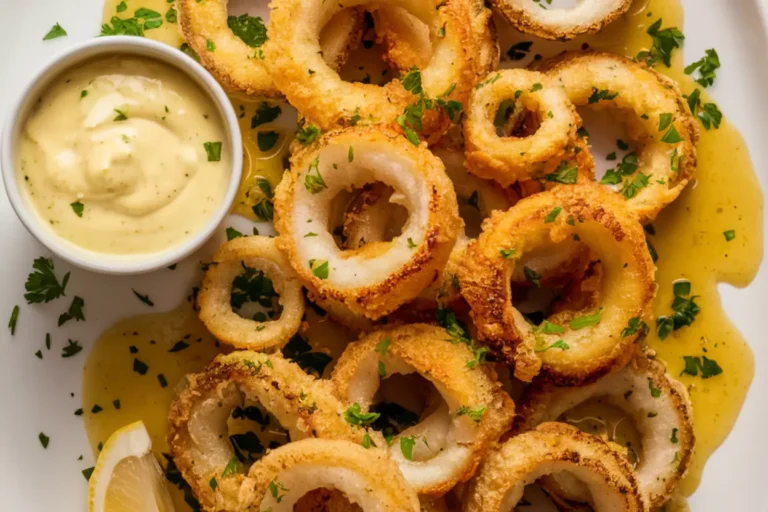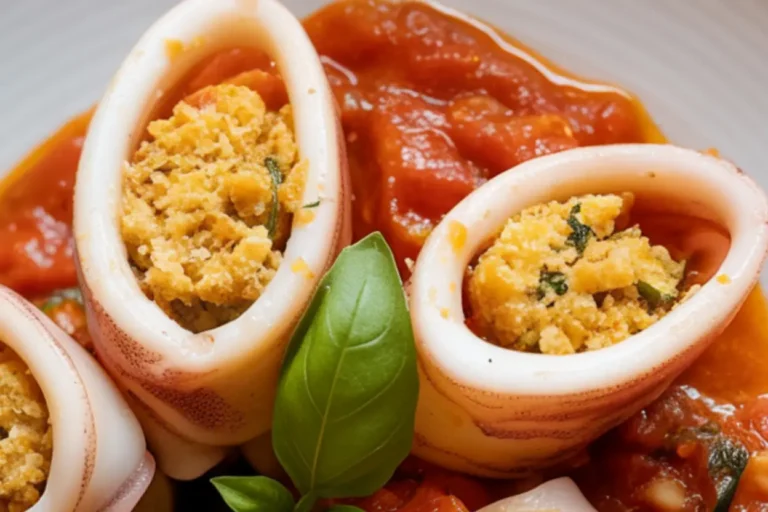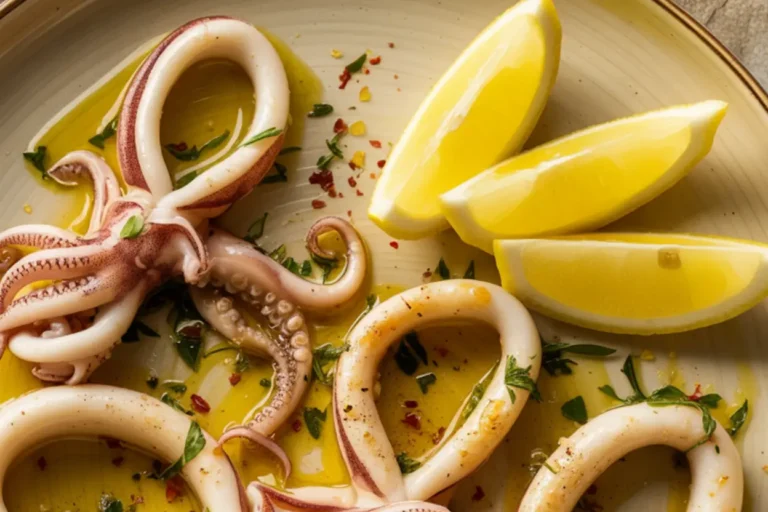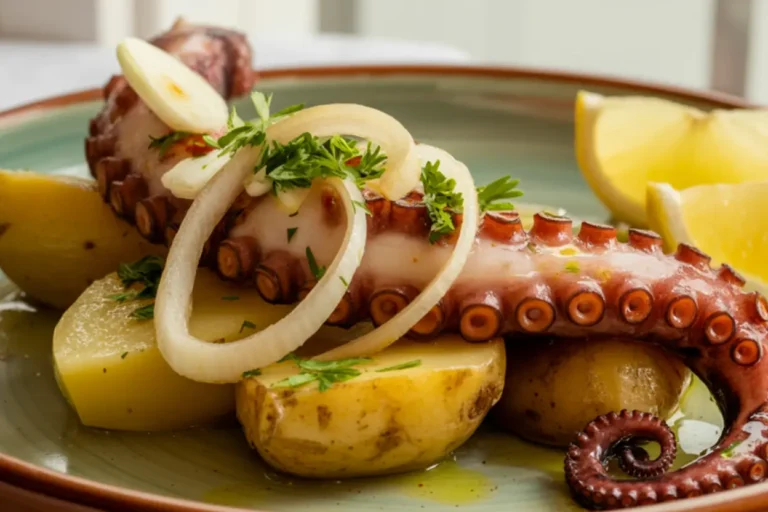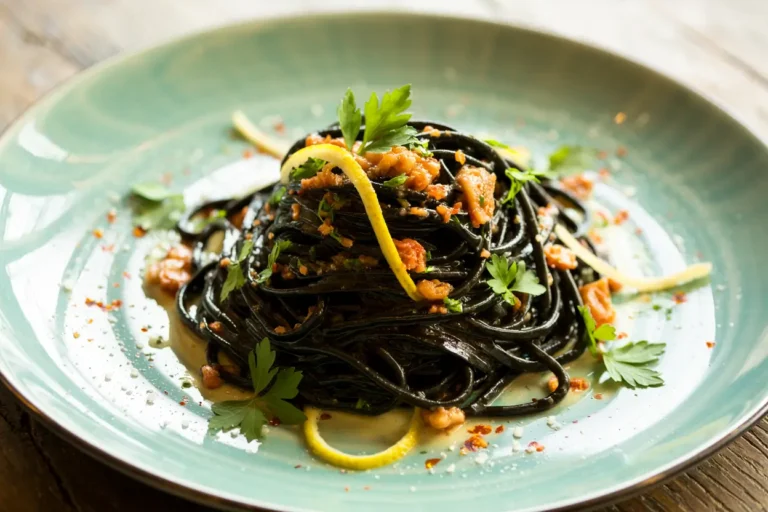Pulpo a la campechana: How to Nail the Classic Recipe
Table of Contents
There’s something magical about a perfectly prepared Pulpo a la Campechana that transforms an ordinary dinner into a coastal Mexican feast. As someone who’s spent years perfecting this classic seafood dish, I’m excited to share my foolproof method that delivers tender octopus bathed in a vibrant, spicy sauce that captures the essence of Campeche’s culinary traditions.
Thank you for reading this post, don't forget to subscribe!How to Make Pulpo a la Campechana
Quick Overview
Pulpo a la Campechana is a showstopping seafood dish from the coastal state of Campeche in Mexico that features tender octopus in a rich, tomato-based sauce with a perfect balance of heat and acidity. What makes this recipe special is how the octopus becomes incredibly tender through a careful cooking technique, while the sauce develops complex flavors from aromatic vegetables and spices. The entire preparation takes about 2 hours, but most of that is hands-off cooking time, and trust me, the results are absolutely worth the wait. This dish delivers a restaurant-quality experience that will transport you straight to Mexico’s Gulf Coast.
The Ingredients I Use to Bring My Pulpo a la Campechana to Life:
For the Octopus:
- 2 pounds fresh or frozen octopus, cleaned
- 2 bay leaves
- 1 white onion, quartered
- 4 garlic cloves, smashed
- 1 tablespoon sea salt
- 1 teaspoon black peppercorns
- Water (enough to cover the octopus)
For the Campechana Sauce:
- 4 tablespoons olive oil, divided
- 1 large white onion, finely diced
- 5 garlic cloves, minced
- 2 jalapeño peppers, seeded and diced (adjust according to heat preference)
- 1 red bell pepper, diced
- 1 green bell pepper, diced
- 4 ripe tomatoes, diced
- 2 tablespoons tomato paste
- 1 teaspoon dried oregano (Mexican if available)
- 1 teaspoon ground cumin
- 1/2 teaspoon ground black pepper
- 1 cup vegetable broth
- 1/4 cup fresh lime juice
- 1/3 cup chopped fresh cilantro, plus more for garnish
- Salt to taste
For Serving:
- Lime wedges
- Fresh cilantro sprigs
- Warm corn tortillas
Step-by-Step Instructions:
Preparing the Octopus:
- Prepare the octopus: If you’re starting with a frozen octopus, let it thaw fully in the fridge overnight. Once thawed, give it a good rinse under cold water, making sure to clean out any bits from the tentacles and head cavity.
- Tenderize the octopus: For extra tender results, place the octopus on a cutting board and gently pound the tentacles with a meat mallet. This helps break down some of the tough fibers.
- Prepare the cooking liquid: Fill a large pot with enough water to fully submerge the octopus. Toss the quartered onion, smashed garlic, bay leaves, a pinch of salt, and a few black peppercorns into the water.
- Cook the octopus: Bring the pot to a boil over high heat. Once boiling, carefully dip the octopus into the water three times, holding it by the head and submerging the tentacles for a few seconds each time. This helps curl the tentacles for presentation. Then fully submerge the octopus in the boiling water.
- Simmer gently: Reduce the heat to maintain a gentle simmer. Cook uncovered for 45-60 minutes, depending on the size of your octopus. To test for doneness, pierce the thickest part of a tentacle with a sharp knife – it should slide in easily when tender.
- Cool and cut: Once tender, remove the octopus from the cooking liquid and let it cool for about 15 minutes. Then cut the tentacles from the head and slice them into 1-inch pieces. Set aside.
Making the Campechana Sauce:
- Sauté the aromatics: Heat about 2 tablespoons of olive oil in a large skillet over medium heat. Add the diced onion and sauté for around 5 minutes, until it turns soft and translucent. Stir in the minced garlic and cook for another minute, just until it smells nice and fragrant.
- Add the peppers: Add the diced jalapeños, red bell pepper, and green bell pepper to the skillet. Cook for about 5 minutes until they begin to soften.
- Incorporate the tomatoes: Add the diced tomatoes and tomato paste to the mixture. Stir well to combine and cook for 8-10 minutes until the tomatoes break down and release their juices.
- Season the sauce: Add the dried oregano, ground cumin, and black pepper to the sauce. Stir well to incorporate all the spices. Pour in the vegetable broth and bring the mixture to a simmer.
- Simmer to develop flavors: Let the sauce simmer uncovered for 15-20 minutes, allowing it to reduce slightly and concentrate in flavor. Stir occasionally to prevent sticking.
- Add the octopus: Gently fold the cooked octopus pieces into the sauce, making sure they’re well coated. Cook for an additional 10-15 minutes on low heat to allow the flavors to meld together.
- Finish the dish: Remove the skillet from the heat and stir in the fresh lime juice and chopped cilantro. Taste and adjust salt as needed.
- Serve: Transfer the Pulpo a la Campechana to a serving platter or individual plates. Garnish with additional cilantro sprigs and lime wedges. Serve immediately with warm corn tortillas.
What to Serve Pulpo a la Campechana With:
This flavorful octopus dish is versatile and can be enjoyed in multiple ways:
- Mexican Rice: A side of fluffy, tomato-infused Mexican rice soaks up the delicious sauce perfectly.
- Black Beans: Simple black beans seasoned with cumin and a touch of lime complement the octopus beautifully.
- Avocado Salad: A crisp salad made with avocado, jicama, and cucumber, all tossed in a zesty lime dressing, brings a refreshing touch to the meal.
- Tostadas or Chips: For a more casual presentation, serve as a topping for tostadas or with tortilla chips for scooping.
- Chilled Beverages: A cold Mexican beer, sparkling mineral water with lime, or a classic agua fresca (try cucumber or hibiscus) helps balance the dish’s heat.
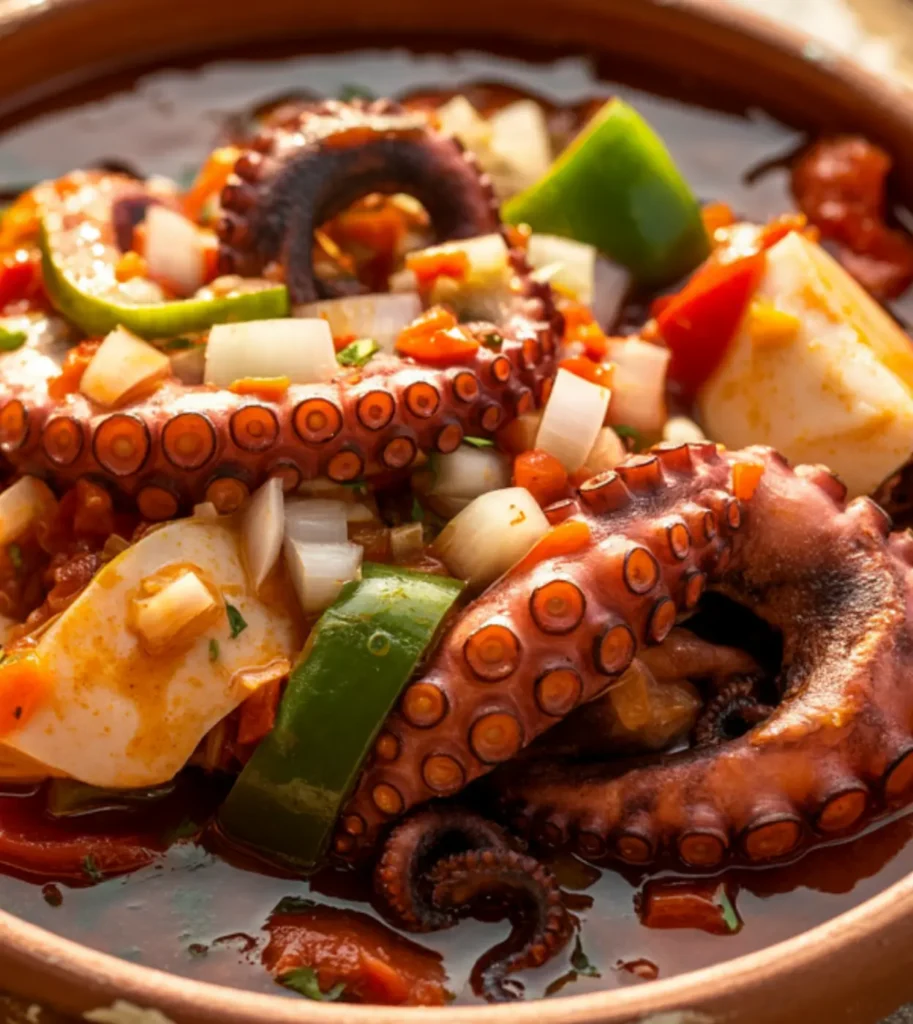
Top Tips for Perfecting Pulpo a la Campechana:
- Octopus Selection: If possible, use fresh octopus that has been properly cleaned. If using frozen, ensure it’s completely thawed before cooking to ensure even tenderness.
- The Three-Dip Technique: Don’t skip the step of dipping the octopus into boiling water three times before fully submerging it. This traditional technique helps curl the tentacles beautifully and starts the tenderizing process.
- Cooking Time Variations: Smaller octopuses may only need 30-45 minutes to become tender, while larger ones could take up to 90 minutes. The key is to check periodically – perfectly cooked octopus should offer slight resistance when pierced, but not be rubbery.
- Cork in the Cooking Water: Some chefs swear by adding a wine cork to the cooking water, claiming it contains enzymes that help tenderize the octopus. While scientifically debated, it’s a traditional technique worth trying!
- Heat Management: Control the level of spice by adjusting the amount of jalapeños. Remember, you can always add more heat with hot sauce at the table, but you can’t remove it once it’s in the dish.
- Sauce Consistency: If your sauce becomes too thick during simmering, add a splash more vegetable broth. If it’s too thin, simmer uncovered for a few extra minutes to reduce.
- Don’t Skip the Acid: The lime juice added at the end is crucial for balancing the rich flavors of the dish – fresh squeezed makes a noticeable difference.
Storing and Reheating Tips:
Refrigeration: Pulpo a la Campechana can be stored in an airtight container in the refrigerator for up to 3 days. The flavors often develop and improve overnight, making this a great make-ahead dish for entertaining.
Freezing: While best enjoyed fresh, you can freeze the dish for up to 1 month. Store in a freezer-safe container with a small amount of the sauce on top to prevent the octopus from drying out. Thaw overnight in the refrigerator before reheating.
Reheating Method: For the best texture, gently reheat in a covered skillet over medium-low heat, adding a tablespoon or two of water if needed to loosen the sauce. Avoid using a microwave, which can make the octopus tough. Heat just until warmed through (about 5-7 minutes), as overcooking will toughen the octopus.
Serving Leftovers Creatively: Transform leftovers into a delicious seafood tostada by cooling the mixture and serving it atop crispy tostadas with a layer of refried beans, shredded lettuce, and a dollop of Mexican crema.
With these detailed instructions and tips, you’re well-equipped to create an authentic and delicious Pulpo a la Campechana that will impress even the most discerning seafood lovers. Enjoy this taste of Mexican coastal cuisine right in your own kitchen!
Pulpo a la campechana: How to Nail the Classic Recipe
Cuisine: MexicanDifficulty: Medium4
servings25
minutes1
hour390–420
kcalPulpo a la Campechana is a vibrant Mexican seafood dish made with tender octopus simmered in a richly spiced tomato-based sauce featuring onions, peppers, garlic, and bold seasonings. Finished with fresh lime juice and cilantro, it’s traditionally served with warm corn tortillas for a satisfying and flavorful meal.
Ingredients
2 pounds fresh or frozen octopus, cleaned
2 bay leaves
1 white onion, quartered
4 garlic cloves, smashed
1 tablespoon sea salt
1 teaspoon black peppercorns
Water (enough to cover the octopus)
4 tablespoons olive oil, divided
1 large white onion, finely diced
5 garlic cloves, minced
2 jalapeño peppers, seeded and diced (adjust according to heat preference)
1 red bell pepper, diced
1 green bell pepper, diced
4 ripe tomatoes, diced
2 tablespoons tomato paste
1 teaspoon dried oregano (Mexican if available)
1 teaspoon ground cumin
1/2 teaspoon ground black pepper
1 cup vegetable broth
1/4 cup fresh lime juice
1/3 cup chopped fresh cilantro, plus more for garnish
Salt to taste
Lime wedges
Fresh cilantro sprigs
Warm corn tortillas
Directions
- Prepare and Tenderize the Octopus
If using frozen octopus, thaw it fully in the refrigerator overnight. Rinse it under cold water, cleaning out any remaining bits. For a more tender result, gently pound the tentacles with a meat mallet. In a large pot, bring water to a boil with onion, garlic, bay leaves, salt, and peppercorns. Dip the octopus tentacles into the water three times to curl them, then submerge completely and simmer for 45–60 minutes until fork-tender. - Cool and Slice the Octopus
Once the octopus is tender, remove it from the pot and let it cool for about 15 minutes. Then, cut the tentacles from the head and slice them into 1-inch pieces. Set the pieces aside while you prepare the sauce. - Sauté the Aromatics and Peppers
In a large skillet, heat 2 tablespoons of olive oil over medium heat. Sauté the diced onion until soft and translucent, then add minced garlic and cook for another minute. Stir in the diced jalapeños, red and green bell peppers, and cook until slightly softened, about 5 minutes. - Build the Campechana Sauce
Add diced tomatoes and tomato paste to the skillet, stirring to combine. Let it cook for 8–10 minutes until the tomatoes break down. Season with oregano, cumin, and black pepper, then pour in the vegetable broth. Simmer the sauce uncovered for 15–20 minutes, stirring occasionally as it thickens and the flavors deepen. - Finish and Serve
Gently fold the sliced octopus into the sauce and let it simmer on low for another 10–15 minutes. Turn off the heat and stir in fresh lime juice and chopped cilantro. Adjust salt to taste. Serve hot, garnished with cilantro sprigs and lime wedges, alongside warm corn tortillas.
Notes
- Pulpo a la Campechana is rooted in coastal Mexican cuisine, blending the natural sweetness of octopus with earthy spices like cumin and oregano, bright acidity from tomatoes and lime, and the subtle heat of jalapeños. For best results, cook the octopus until fork-tender, and don’t skip the fresh cilantro—it adds a key herbal note. Serve with warm corn tortillas for a true taste of Mexico’s seaside kitchens.

